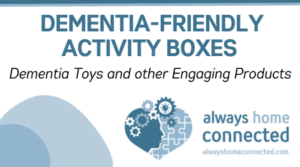The Overlap Between Autism and Alzheimer’s: Unveiling the Connections
 Submitted by Mary Anne Roberto,
Submitted by Mary Anne Roberto,
The Co-founder of
Always Home Connected
Overlapping symptoms between Alzheimer’s disease and Autism surprises many.
In the realm of neurological and developmental disorders, two conditions have sparked significant interest: Autism Spectrum Disorder (ASD) and Alzheimer’s Disease. While these conditions primarily affect different age groups and present with distinct characteristics, recent research suggests there may be intriguing overlaps between them. This blog delves into the connections between autism and Alzheimer’s, exploring the shared features, underlying mechanisms, and potential implications for understanding and treating both conditions.
Understanding Autism Spectrum Disorder (ASD)
Autism Spectrum Disorder is a developmental disorder characterized by difficulties in social interaction, communication, and repetitive behaviors. It is typically diagnosed in early childhood, with symptoms varying widely among individuals. Some common features of ASD include:
- Social communication challenges: Difficulty understanding social cues, forming relationships, and engaging in typical social interactions.
- Repetitive behaviors: Engaging in repetitive movements or routines and having a strong preference for sameness.
- Sensory sensitivities: Over- or under-reacting to sensory stimuli such as sounds, lights, textures, or smells.
The prevalence of autism has been rising, with current estimates suggesting that about 1 in 54 children in the United States is diagnosed with ASD. The causes of autism are multifactorial, involving a combination of genetic and environmental factors.
Understanding Alzheimer’s Disease
 Alzheimer’s Disease is a neurodegenerative disorder that primarily affects older adults. It is the most common cause of dementia, characterized by progressive memory loss, cognitive decline, and behavioral changes. Key features of Alzheimer’s include:
Alzheimer’s Disease is a neurodegenerative disorder that primarily affects older adults. It is the most common cause of dementia, characterized by progressive memory loss, cognitive decline, and behavioral changes. Key features of Alzheimer’s include:
- Memory impairment: Difficulty remembering recent events, conversations, and eventually even personal information.
- Cognitive decline: Challenges with problem-solving, decision-making, and performing everyday tasks.
- Behavioral changes: Mood swings, confusion, disorientation, and changes in personality.
Alzheimer’s affects approximately 6 million Americans and is the sixth leading cause of death in the United States. The disease’s pathology involves the accumulation of amyloid plaques and tau tangles in the brain, leading to neuronal damage and death.
Shared Features and Overlapping Symptoms
Despite the differences in age of onset and primary symptoms, there are several areas where autism and Alzheimer’s intersect:
- Communication Difficulties: Both conditions can involve significant challenges in communication. In autism, these challenges are often present from an early age, while in Alzheimer’s, they typically emerge as the disease progresses.
- Repetitive Behaviors: Repetitive behaviors are a hallmark of autism, but they can also be observed in individuals with Alzheimer’s. For example, repetitive questioning or actions are common in Alzheimer’s patients.
- Sensory Processing Issues: Sensory sensitivities are prevalent in autism and can also occur in Alzheimer’s, where patients might become overly sensitive to noise, light, or other stimuli.
Underlying Mechanisms: A Shared Pathology?
Recent research has begun to uncover potential shared biological mechanisms between autism and Alzheimer’s:
- Neuroinflammation: Both conditions involve neuroinflammatory processes. Chronic inflammation in the brain is a common feature, which may contribute to neuronal damage and cognitive deficits. A study published in “Frontiers in Neuroscience” highlights the role of neuroinflammation in both autism and Alzheimer’s, suggesting that targeting inflammatory pathways could be beneficial for both conditions.
- Genetic Links: Some studies have identified genetic mutations and pathways that are common to both autism and Alzheimer’s. For instance, abnormalities in synaptic function and neurotransmitter signaling are implicated in both disorders. Research published in the “Journal of Alzheimer’s Disease” has found that certain genetic risk factors for Alzheimer’s may also be associated with autism, indicating a possible genetic overlap.
- Oxidative Stress: Oxidative stress, which refers to cellular damage caused by free radicals, is another shared factor. It can lead to neuronal damage and has been observed in both autistic individuals and Alzheimer’s patients. A review article in “Molecular Neurobiology” discusses the role of oxidative stress in both conditions and how it contributes to their pathogenesis.
Cognitive and Behavioral Overlaps
While autism is primarily a developmental disorder and Alzheimer’s a degenerative one, the cognitive and behavioral symptoms of the two conditions can sometimes mirror each other. For example:
 Executive Functioning Deficits: Both individuals with autism and those with Alzheimer’s can experience difficulties with executive functions, such as planning, organizing, and multitasking. These deficits can significantly impact daily living and independence.
Executive Functioning Deficits: Both individuals with autism and those with Alzheimer’s can experience difficulties with executive functions, such as planning, organizing, and multitasking. These deficits can significantly impact daily living and independence.- Social Withdrawal: Social withdrawal and isolation are common in both conditions. Autistic individuals may struggle with social interactions from a young age, while Alzheimer’s patients may withdraw socially as their cognitive abilities decline.
- Emotional Regulation: Challenges with emotional regulation are observed in both autism and Alzheimer’s. Individuals with autism may have difficulty understanding and expressing emotions, while those with Alzheimer’s may experience mood swings and changes in personality.
Implications for Research and Treatment
Understanding the overlap between autism and Alzheimer’s has significant implications for research and treatment strategies:
 Early Detection and Intervention: Insights into shared mechanisms could lead to the development of biomarkers for early detection and intervention, potentially improving outcomes for both conditions. For instance, identifying common genetic markers or inflammatory pathways could enable earlier diagnosis and targeted treatments.
Early Detection and Intervention: Insights into shared mechanisms could lead to the development of biomarkers for early detection and intervention, potentially improving outcomes for both conditions. For instance, identifying common genetic markers or inflammatory pathways could enable earlier diagnosis and targeted treatments.- Therapeutic Approaches: Treatments targeting neuroinflammation, oxidative stress, and synaptic dysfunction may benefit individuals with either condition. Exploring common pathways could lead to innovative therapies that address the root causes of both autism and Alzheimer’s. For example, anti-inflammatory drugs or antioxidants might be effective in mitigating symptoms in both disorders.
- Personalized Medicine: A deeper understanding of the genetic and molecular underpinnings of these disorders could pave the way for personalized medicine approaches, tailoring treatments to the specific needs of each individual. This could involve using genetic profiling to identify individuals at risk for both conditions and developing customized treatment plans.
Conclusion
While autism and Alzheimer’s are distinct conditions affecting different populations, the emerging evidence of their overlap opens new avenues for research and therapeutic development. By unraveling the connections between these two disorders, scientists and clinicians can work towards better understanding, early detection, and effective treatments, ultimately improving the quality of life for individuals affected by autism and Alzheimer’s.
By fostering a deeper understanding of these connections, we can hope to develop more effective interventions and support systems for those affected by autism and Alzheimer’s, leading to better outcomes and improved quality of life.
 Submitted by Mary Anne Roberto,
Submitted by Mary Anne Roberto,
The Co-founder of Always Home Connected
About The Author
 Mary Anne Roberto is the Owner and CEO of Elder-Well Adult Day Program and co-founder of Always Home Connected. She is a dedicated Dementia Care Specialist (DCS) and Advocate, a Certified Nursing Assistant (CNA), and a Certified Positive Approach To Care Consultant under Teepa Snow. Specializing in dementia care, Mary Anne aims to raise awareness about cognitive changes and provide caregivers with the necessary resources and tools to help alleviate daily challenges faced by caregivers.
Mary Anne Roberto is the Owner and CEO of Elder-Well Adult Day Program and co-founder of Always Home Connected. She is a dedicated Dementia Care Specialist (DCS) and Advocate, a Certified Nursing Assistant (CNA), and a Certified Positive Approach To Care Consultant under Teepa Snow. Specializing in dementia care, Mary Anne aims to raise awareness about cognitive changes and provide caregivers with the necessary resources and tools to help alleviate daily challenges faced by caregivers.

 Executive Functioning Deficits: Both individuals with autism and those with Alzheimer’s can experience difficulties with executive functions, such as planning, organizing, and multitasking. These deficits can significantly impact daily living and independence.
Executive Functioning Deficits: Both individuals with autism and those with Alzheimer’s can experience difficulties with executive functions, such as planning, organizing, and multitasking. These deficits can significantly impact daily living and independence. Early Detection and Intervention: Insights into shared mechanisms could lead to the development of biomarkers for
Early Detection and Intervention: Insights into shared mechanisms could lead to the development of biomarkers for 